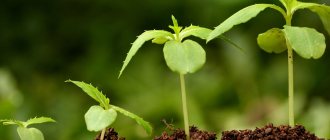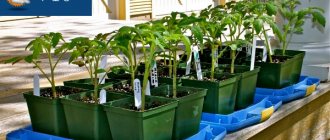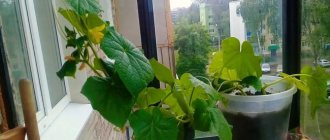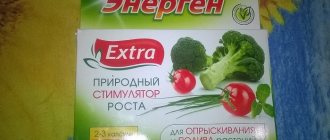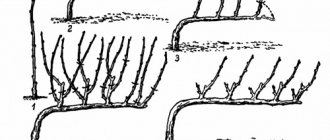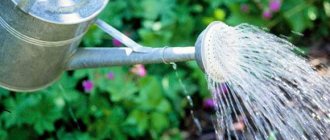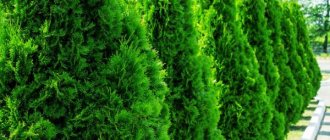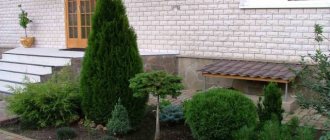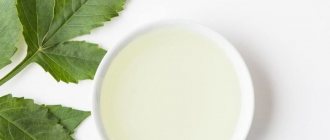Organic plant growth stimulator.
Aloe juice can also be used as a stimulant. However, when using aloe juice, the biological compatibility of plants must be taken into account. Aloe juice is especially beneficial for tomato seeds.
It can be used for soaking eggplant, cabbage and lettuce seeds, but is not suitable for pepper, onion, celery and pumpkin seeds.
For soaking, use undiluted aloe juice obtained from three-year-old or even older leaves that have an intense green color. Lightened or yellowed leaves and leaves with dry tips are not suitable.
The lower leaves of a perennial plant are broken off and placed in the refrigerator for a week, after which the juice is squeezed out of them. Soaking in aloe juice does not replace disinfection; it should be done after heating the seeds.
Preparing seeds for planting
Tomato seeds are kept in aloe juice for 24 hours, and then sown or placed for germination without washing off the juice.
That is, I try to use what is most safe. Although only humic fertilizers have been the most studied, we can definitely say that they exhibit a positive physiological effect in animal organisms and in the human body.
Fertilizing plants with sugar
Experienced gardeners often use sugar as a top dressing. For example, cacti and ficus simply need sugar and glucose, which is obtained as a result of the breakdown of sugar.
Glucose helps form complex molecules that serve as building blocks for plants, and it also serves as a source of energy.
Latest articles about gardening
Urea fertilizer application in the garden
Mulching cucumbers in open ground
Mulching strawberries with sawdust
To feed green plants with sugar, you can dilute it in water and pour sugar water over them, or sprinkle granules on the ground and then water. This procedure should be carried out once a month.
Humic fertilizers.
These include Tellurium and Flora preparations; they are obtained from natural raw materials: peat, brown coal, sapropel. These fertilizers contain nitrogen, phosphorus and potassium, but there is so little of them that it is not possible to talk about them as a source of NPK.
Humic substances introduced with fertilizers of this type primarily change the physical properties of soils. The moisture capacity of light soils increases, the water permeability of heavy soils, the structure of the soil improves, and its density decreases.
When using humic fertilizers, an increase in the microbiological activity of the soil is observed, both in the first year of fertilization and subsequently. Simultaneously with the increase in the number of microorganisms, the enzymatic activity of the soil also increases. Which in turn increases the mobility of soil nutrients.
Article on the topic: Potassium humate use in the garden.
Thus, the use of humic fertilizers significantly changes the soil nutrition conditions of plants. Causing an active enhancement of the processes of mobilization of nutrients in a form digestible by plants.
Stimulators and regulators of root and leaf growth
This category includes drugs that improve root formation, ground mass growth, and fruiting. The active substances used for these purposes belong to the biological group of phytohormones. They mobilize plants to direct energy in the right direction. At the same time, vital processes are activated and immunity is increased. As a result, growth, flowering and fruiting are improved, as well as resistance to infection by diseases and pests.
Types of phytohormones, their effect on plants.
Auxins.
They are responsible for the development of the root system and the distribution of nutrients throughout the plant.
Heteroauxin.
The drug stimulates root formation. To do this, the root system of plants before planting is soaked for 8-24 hours in an aqueous solution of heteroauxin. After planting, it is useful to water the plant with this solution. To increase the effectiveness of heteroauxin during rooting and cuttings, plants are treated jointly with zircon (1 ampoule per 1 liter of water) and heteroauxin (200 mg per 1 liter of water).
It is also used to stimulate fruit formation and obtain seedless fruits. The concentration of heteroauxin for treating carrot seeds is 600 mg per 1 liter of solution, table beets – 800 mg, tomatoes, cucumbers – 500 mg/liter. Combined use with vitamins enhances the effect of heteroauxin.
By the way, other stimulants, for example, succinic acid, are recommended to be used in conjunction with vitamins. Stimulants are mixed with vitamins in a ratio of 600 mg/liter of heteroauxin + 100 mg of vitamin B1 or the same amount of nicotinic acid, or all three components.
Carrot, beet, and onion seeds are treated with this solution for 10-12 hours.
Kornevin.
This is an analogue of heteroauxin. Before planting, for better survival, the root system of plants is powdered with root.
Succinic acid.
Colorless, odorless powder, highly soluble in alcohol and water. It is found naturally in small quantities in almost all plants. And also in amber, brown coal and maleic anhydride, from which it is mainly extracted for industrial purposes.
Succinic acid stimulates fruit formation. Spraying potato plants with a 0.01% solution of succinic acid accelerates flowering, potatoes are less affected by late blight, and the yield increases by 35-50 kg per hundred square meters.
Succinic acid is also used to process tomatoes. Spraying of plants to increase productivity is carried out during the budding period (40-60 mg/l) and repeated three times. The interval between treatments is 7 days. The solution consumption is 2 liters per hundred square meters.
Article on the topic: How to use succinic acid for plants
Immunocytophyte.
Substance of auxin nature. Stimulates growth processes. The drug helps to significantly increase the immunity of plants and their resistance to many common diseases. Such as late blight, alternaria, rhizoctonia, various types of scab, blackleg, powdery mildew, bacteriosis.
The drug is used both for treating seeds and tubers before sowing and during the growing season of plants. After treatment, increased disease resistance persists for one to two months.
Immunocytophyte is intended for processing potatoes, tomatoes, cucumbers, cabbage, onions, as well as fruit and berry crops, grapes, and flowers.
Biostim.
It is a growth regulator of natural origin. It is a complex of phytohormones of auxin and gibberellin nature. Biostim is recommended to be used to accelerate seed germination, when picking and planting seedlings, to improve the rooting of seedlings.
Increases productivity by accelerating plant cell division. After all, the faster the cells divide, the faster the plant grows. Of course, provided that these plants have everything they need to develop. Therefore, with a minimum supply of food (fertilizers), the yield will increase by 20-30 percent.
Extends the life of old trees, shrubs and berry gardens. Makes them bear fruit vigorously again.
Stimulates the growth of bacteria. If, when propagating an “EM” culture, you make a nutrient solution with “Biostim”, then the number of soil-forming bacteria will increase many times.
Therefore, Biostim is a good adaptogen. It strengthens the plant’s immune system and helps it survive unfavorable periods of life and cope with disease. Spraying plants with biostim helps accelerate growth and increase plant productivity.
The drug “Biostim” is sold in sachets. The contents of the bag are diluted in hot water and infused like tea. The resulting mother solution is stored in the refrigerator for up to 1-1.5 months. To prepare the working solution, use a syringe to take 1 ml of the stock solution for each liter of water consumed.
The drug is applied with any sprayer or watering can at the rate of 1 liter per 5 square meters. m of planting area.
Thus, the consumption of the initial dry matter is 1 gram per 1 ha of vegetable crops.
Iodine and potassium permanganate – growth enhancers for plants
Ordinary pharmaceutical iodine brings a lot of benefits to the garden.
For example, mix 7-8 iodine drops in 10 liters of water, sprinkle the resulting mixture on strawberry and strawberry bushes before they bloom, this will give them vitality. This must be done a couple of times with an interval of 10 days.
If you water tomato seedlings once with this mixture: stir 1 drop of iodine in 3 liters of water, then in the future this will help increase the yield and increase the size of the fruit. When the seedlings are planted in the ground, they should be fed with iodine one more time. Add 3 iodine drops to a bucket of water (10 liters) and pour 1 liter under each bush.
As for potassium permanganate, a solution from it is used, first of all, to destroy possible pathogenic bacteria on seeds; gardeners call this “treating the seeds.” A light solution of potassium permanganate (0.5 g per 100 ml of water), pale pink, is made, and plant seeds are soaked in it for 20 minutes, then washed and dried. The main thing is not to make the solution too concentrated so as not to burn the seeds. And you shouldn’t water it often with “rose water”; this may not have a very good effect on the future harvest.
Brassinolides.
Supports the normal functioning of the plant immune system. Increases resistance to disease. They also regulate the ripening processes of fruits and seeds.
Epin-Extra.
Anti-stress drug. Belongs to the group of brassinolides. These are hormones that maintain the normal immune system of plants. Especially in stressful situations such as low temperatures, frost, flooding, drought, disease, pesticides, soil salinity.
Brassinolides are contained in every plant cell, but their natural level in a changed environmental situation is often not high enough to maintain immunity and normal development of the plant throughout the growing season.
Small clarification. Due to widespread counterfeiting, the drug called “Epin” was discontinued back in 2003. And it was replaced by an improved substitute, Epin-Extra. Having a high degree of protection against counterfeiting, as it was patented and registered in accordance with the law of the Russian Federation.
Seeds treated with epin germinate faster, and seedlings obtained from such seeds are immune to many common diseases. Such as blackleg, late blight, rhizoctonia, powdery mildew. In addition, plants become more resistant to weather changes and even to such unfavorable phenomena as drought, frost, and chemical soil pollution.
It is also important that the products grown are of high quality and have a reduced content of heavy metals, nitrates, and residual pesticides. It has also been established that the drug has an activating effect on the shoot formation of fruit and berry crops, grapes, flowers, and ornamental shrubs.
The use of epin.
To prepare the solution, shake the package removed from the refrigerator and warm it for 30 minutes at room temperature or 2-3 minutes in your hand. As a result, the precipitate disappears and the contents of the test tube become transparent.
Shake the test tube vigorously several times. Epine treatment is always carried out after seed disinfection. For example, warming up in hot (+50-52 degrees) water for 20-25 minutes, then in cold water for 3 minutes.
But here you need to remember that after treatment with hot water, 20-30% of the seeds may lose their viability. That is, weak seeds will die.
The seeds of most vegetable crops are soaked at the rate of 3-6 drops per 50 ml of warm boiled water. For soaking tubers and bulbs - 1 ampoule per 2 liters of water. Soak seeds, tubers, and bulbs in Epine solution for 18-24 hours. After this, the seeds are either dried and sown, or put in melt water to germinate.
Silk.
Natural fungicide and growth stimulator. Increases the yield of vegetable crops by 25-30%. Helps increase the vitality of plants in extreme climatic conditions (drought, frost). Reduces the incidence of plant diseases such as late blight, downy mildew, brown rust, root rot, wilt, and bacterial black spot.
Thanks to the pine needles included in the composition, the drug has a pleasant smell. It dissolves instantly in water and retains its properties for a long time. Pine needle extract has a stimulating effect on the plant’s immune system and improves its protective qualities.
Silk is used on tomatoes, cucumbers, cabbage, onions, and potatoes.
Silk must be dissolved in 100-200 ml of water. The water temperature should be 35-60 degrees. The concentration of the composition depends on what crop you will process. It will take 10-15 minutes to dissolve the composition.
The drug can be used in two ways:
- Soaking seeds. Planting material must be placed in the prepared working composition for 2 hours. After the procedure, you should wait until the seeds dry completely. You can use a simpler method - spray the seeds with the mixture and let them dry;
- Spraying. Apply the composition to the leaf part, flowers and ovaries using a sprayer. The procedure is carried out during the growing season of plants.
Zircon.
Plant growth and development regulator, root former, flowering inducer. Derived from plant materials. Increases germination and germination energy of seeds. Accelerates flowering, growth and development of plants by 5-10 days. Ripening time is reduced by 1-2 weeks. Productivity increases by 35-60%.
As a result, the use of zircon sharply reduces the degree of damage to diseases such as late blight of potatoes and tomatoes, peronosporosis of cucumbers, scab of potatoes and apple trees, bacteriosis and fusarium of vegetable and flower crops, gray rot of strawberries, and especially powdery mildew of black currants.
Has high root-forming activity. Promotes rooting of seedlings and cuttings. Accelerates their survival rate during transplantation and reduces the accumulation of heavy metals.
For pepper seeds, excellent results are obtained by 16-18 hour treatment at a temperature of 23-25 degrees and when diluting zircon - 1 drop per 300 ml. water. For corn, cucumber and pumpkin seeds – 2 drops per 300 ml. and 10 hours of processing.
Microfertilizers.
Tsitovtit.
The drug contains a full complex of microelements in an organic form that is most accessible to plants. Increases the productivity of fruit, berry and vegetable crops, and the decorativeness of flower crops.
Soaking seeds and fertilizing with cytovit accelerates seed germination and plant growth, increases plant resistance to unfavorable growing conditions and overwintering. They reduce the fall of the ovary, prevent the death of growing points and the disease of fed crops with such diseases. Such as chlorosis, various leaf spots, “rosette” of fruit, rot.
The greatest effect is achieved by jointly treating seeds, seedlings and vegetative plants with epin-extra and cytovit, and for root crops with zircon and cytovit.
Stimulators of kidney growth and cell division (cytokinins)
Cytokinin paste
Using a toothpick, apply a small amount of paste to a fresh cut made on the plant, or to the place where the bud should be. Please note that an overdose of the drug will lead to inhibition of growth and deterioration in the general condition of the plant.
Keikigrow Plus
This is a Canadian analogue of cytokinin paste. The action and method of use of these drugs are identical.
Cytodef
This drug stimulates seed germination, shoot growth, and increases the yield of fruit trees. It is used as an additive to pesticides.
Gibberellins.
Stimulates seed germination, flowering and fruit formation. Increases productivity. They also remove tubers and bulbs from dormancy. Unlike Auxins, they do not redistribute nutrients but only accumulate them.
Gibberellin.
It affects the functioning of the chromosomal apparatus. Capable of significantly influencing the length of the stem. At the same time, it can stimulate both cell division and cell elongation. At the same time, gibberellin does not affect root growth, and in increased concentrations in a water culture it even worsens the condition of the roots.
Gibberellin also activates seed germination, fruit growth, and delays the reddening of tomatoes. It is known that dormant buds and seeds of a number of species are brought out of dormancy by the action of low temperatures.
The temperature factor in these cases can be replaced by treatment with gibberellin. Photosensitive seeds require light to germinate. It can also be replaced with gibberellin.
Gibberellin is used to increase the yield of sultana (seedless) grape varieties, characterized by relatively small berries. Spraying the grapevine with a solution of 30 mg per 10 sq.m. during flowering or 5-7 days after flowering, it helps to increase the size of the berries by 1.5-2.5 times and increase the yield by 50-100%.
In addition, the ripening of grapes is accelerated by several days. But, in fairness, it must be said that sultanas made from processed grapes are worse.
Gibberellin also has a positive effect on some seed grape varieties. The number of berries increases, the number of seeds and seedlessness increases, the cluster loosens, which reduces the susceptibility of berries to phytopathogens, and ripening accelerates.
In order to increase productivity, gibberellin is also used to treat strawberry plantations.
We prepare a growth stimulator for plants at home.
While many plants themselves are sources of growth stimulating substances, we can provide ourselves with a plant growth stimulator in a simple, simple way. As a result of the study, scientists discovered that the maximum release of such hormones occurs at the stage of seed germination without access to light.
The largest amount of phytohormones is released by seedlings of grain crops: wheat, rye, barley and oats. As well as seeds of cruciferous plants, rapeseed, oilseed radish and mustard.
What needs to be done to get a plant growth stimulator at home? First of all, we need to germinate the seeds. I will tell you using wheat as an example, since it is the easiest to obtain, but the most effective preparation is obtained from mustard sprouts.
We prepare raw materials.
So we take the wheat seeds, weigh them, remember the weight, then thoroughly wash them to remove debris. We also do not need those seeds that will float on the surface of the water; we discard them. Fill the seeds with water so that the seeds are completely submerged and give them time to swell. This process takes from 6 to 12 hours.
Drain the water and cover the seeds with a damp cotton cloth folded in several layers. To ensure good gas exchange, it is better to germinate seeds in a container with a wide bottom. For example, this could be an enamel pan. The main thing during such germination is to protect our seedlings from light. Cover the pan with an additional lid.
The first millimeter-sized seedlings will appear within a day, but this is not enough for us. It is necessary to wait a week until the cotyledon leaves of the cruciferous vegetables appear and the grains sprout. Now they are completely ready for the extraction of growth stimulants.
The next stage of preparing a plant growth stimulator with your own hands is to grind the sprouts in any convenient way. A blender is perfect for these purposes. The finer you grind them, the better it will be. To make grinding easier, you can add a little water to the blender or chopper.
Next, to prepare the concentrate, we remember the weight of the seeds obtained by weighing them and for every 100 grams. seeds, add 1 liter of water, and leave for 3-4 hours. For example, for 150 grams of seeds you will need to add 1.5 liters of water.
Next, we filter through cheesecloth and we get a ready-to-use growth-stimulating drug.
Use of a growth-stimulating drug.
The drug can be used without additional dilution with water for soaking seeds, for dipping the root system when picking seedlings.
Article on the topic: What is pickling and how is it useful for plants.
For foliar treatment of plants or watering at the root, it is necessary to dilute the resulting solution with water 5 times. Watering with this preparation is best done immediately after planting.
This drug has a good effect on the germination of seeds and the energy of seed germination and the survival rate of seedlings. In addition, if your plants look frail, you can always treat them with this drug. But we must remember that you should not use this drug when fruits have already formed on tomatoes, peppers and eggplants. Because it can cause an abundant increase in vegetative mass.
But cucumbers, cabbage, beets, zucchini and pumpkin respond well to this drug. This drug has proven itself well when growing greens: onions, garlic, parsley and so on.
Functions of stimulant drugs
Biostimulants are successfully used at home and on an industrial scale in fields, greenhouses, greenhouses.
Intended for:
- accelerating the formation of the root system, increasing the survival rate of seedlings;
- rejuvenation of aged plants and strengthening of young ones;
- formation of a large amount of green mass of plants, acceleration of shoot growth and division process;
- acceleration of ovaries, preservation of abundant and long-lasting flowering;
- enhancing the color shades of the plant;
- instilling resistance to adverse weather conditions and pest attacks;
- recovery from mechanical damage, elimination of the consequences of unscrupulous care;
- increasing seed germination and vegetative properties of cuttings.
Artificial preparations are enhanced with special biological additives and nutrients, but the basis is taken of natural phytohormones, which are contained in foods familiar to humans.
We prepare biostimulants for plant rooting with our own hands.
In addition to purchased growth stimulants, homemade growth stimulants are also widely used in home gardening. The water in which willow branches took root can successfully replace purchased rootstock.
Biostimulator from willow branches.
To prepare a root formation biostimulator with our own hands, we will need young willow branches with a diameter of no more than 5 ml. Cut them together with the leaves. We tear off the leaves from the bottom of the cuttings from the bottom to the top by 15-20 centimeters. It all depends on the length of the cuttings themselves.
Then we wash the areas of the cuttings bare of leaves in a soap solution. In order to prevent bacteria from getting into our biostimulator from the bark of cuttings. And we supply them with water for root formation.
Literally a week or 10 days later, the process of willow root formation begins even earlier. As soon as you see that the roots have begun to form, cuttings from the water are removed; we no longer need them.
We have received a composition that has amazing properties. Even plants that do not form roots well when rooted in willow water show very good rooting results.
In addition, this water can simply be used to water plants that are not growing well. Willow water can also be used both for rooting and for watering weakened indoor plants.
Biostimulator from honey.
The next biostimulant is honey. To do this, take regular water, not chlorinated. For a liter of water we take a teaspoon of honey and dissolve it in water. The water must be warm so that the honey is completely dissolved.
Then we place the cuttings in this honey water. And they stay there for 24 hours. After this, they are transferred to ordinary water. As a result, the rooting process goes many times faster. And the most important thing is that plants rooted in this way improve their immunity.
Biostimulator from Aloe.
The third biostimulant for rooting cuttings is tremors. To prepare the biostimulant, we need 50 grams of raw yeast and half a liter of water. If you have dry yeast on hand, then pour almost the entire pack into a liter of water and stir. We do not add any sugar to the yeast solution.
We place cuttings of plants that need to be rooted in this solution. The cuttings stand in the yeast solution for 12-14 hours, you can leave them overnight. In principle, there is nothing so terrible about this. In the morning we take them out and place them in regular water.
Another ancient biostimulator for rooting cuttings is aloe. Moreover, you can use aloe, not necessarily aloe vera. The main thing is that the leaves are old, not young. Take two or three good old leaves and chop them up. The result is such a knitting mush. You can, of course, use this pulp, but it’s better, of course, to try to squeeze out the juice.
Take 5-6 drops of aloe juice per glass of water, 200 grams glass of water, and the biostimulator for rooting cuttings is ready. We put the cuttings there for a day. Then we transfer them to ordinary plain water. The rooting process after such stimulation also goes many times faster. This has already been tested several times.
